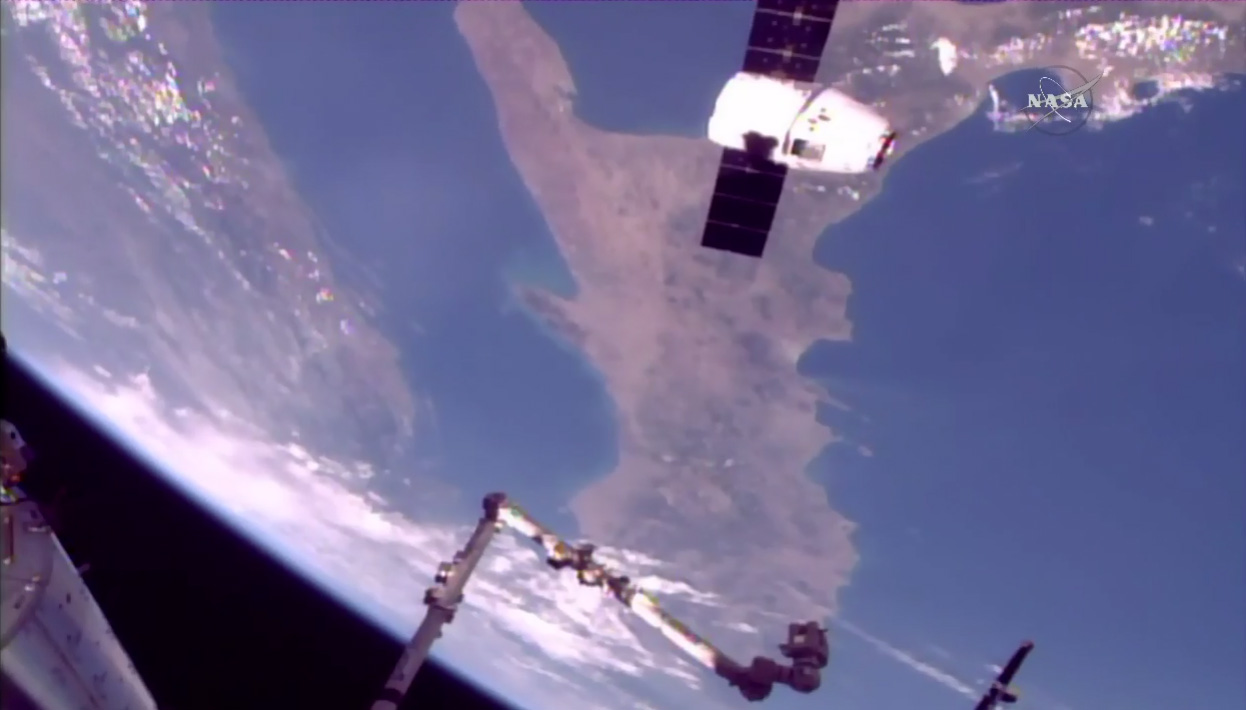SpaceX Dragon Delivers Supplies (and Science) to Space Station
A SpaceX Dragon cargo ship arrived at the International Space Station early Wednesday (Aug. 16), delivering 3 tons of supplies, experiments and even some ice cream for the orbiting lab's crew.
The uncrewed Dragon spacecraft was captured by astronauts using the station's robotic arm at 6:52 a.m. EDT (1052 GMT) as the two spacecraft were flying over the Pacific Ocean, just north of New Zealand.
"Congratulations on a job well done," astronaut Andreas Morgenson of the European Space Agency radioed the station's crew from NASA's Mission Control in Houston. "You've just earned yourself some food." [Watch SpaceX Launch Dragon, then Land a Rocket]
The Dragon cargo ship is filled with more than 6,400 lbs. (2,900 kilograms) of supplies, science experiments and food - and yes, ice cream - for the space station's Expedition 52 crew. SpaceX launched delivery mission Monday (Aug. 14) on a Falcon 9 rocket, which then returned its first stage to Earth in a smooth landing.
Called SpaceX-12 or CRS-12, this flight is SpaceX's 12th cargo flight for NASA under the Commercial Resupply Service program. NASA initially agreed to buy 12 delivery flights from SpaceX, but has extended the agreement to include 20 flights. SpaceX did lose one mission in 2015 when a Falcon 9 rocket failed during liftoff, but the rest have been a success.
"Today has special significance because SpaceX-12 is the last flight on the original cargo resupply contract," NASA astronaut Jack Fischer said from the station. "And this, the 36th flight of a Dragon, stands as a testament to a burgeoning commercial industry that has become a pillar of support to NASA's — and really all of humanity's — quest to explore the universe."

Get the Space.com Newsletter
Breaking space news, the latest updates on rocket launches, skywatching events and more!
Fischer and ESA astronaut Paolo Nespoli captured the Dragon using the station's robotic arm. At one point, cameras on the space station captured Dragon as it soared high over Italy, Nespoli's home country.
Most of the cargo riding on Dragon is science gear, a massive haul that includes a protein crystal experiment to research a new treatment for Parkinson's disease, an experiment to grow lung tissue from stem cells and 20 live mice to help scientists study the effects of long space missions. The U.S. Department of Defense also has a small microsatellite prototype on board, and the Cosmic Ray Energetics and Mass for the International Space Station (which has the tasty acronym ISS-CREAM) will study cosmic rays.
The Dragon spacecraft will stay docked to the space station for about a month, after which it will be filled with science experiment results and other items for the return to Earth.
NASA has used SpaceX and another spaceflight company, the Virginia-based Orbital ATK, to make commercial resupply flights the space station since 2012. The space agency has since picked SpaceX, Orbital ATK and a third company —Sierra Nevada Corp. — to make future deliveries under a new agreement.
In addition to cargo delivery flights, SpaceX will fly NASA astronauts to the space station on a crewed version of the Dragon spacecraft. (NASA has also picked Boeing for astronaut trips to space using that company's CST-100 Starliner spacecraft.)
The first crewed flights on Dragon and the Starliner are expected in mid-2018, NASA has said.
Email Tariq Malik at tmalik@space.com or follow him @tariqjmalik and Google+. Follow us @Spacedotcom, Facebook or Google+. Original story on Space.com.
Join our Space Forums to keep talking space on the latest missions, night sky and more! And if you have a news tip, correction or comment, let us know at: community@space.com.

Tariq is the Editor-in-Chief of Space.com and joined the team in 2001, first as an intern and staff writer, and later as an editor. He covers human spaceflight, exploration and space science, as well as skywatching and entertainment. He became Space.com's Managing Editor in 2009 and Editor-in-Chief in 2019. Before joining Space.com, Tariq was a staff reporter for The Los Angeles Times covering education and city beats in La Habra, Fullerton and Huntington Beach. In October 2022, Tariq received the Harry Kolcum Award for excellence in space reporting from the National Space Club Florida Committee. He is also an Eagle Scout (yes, he has the Space Exploration merit badge) and went to Space Camp four times as a kid and a fifth time as an adult. He has journalism degrees from the University of Southern California and New York University. You can find Tariq at Space.com and as the co-host to the This Week In Space podcast with space historian Rod Pyle on the TWiT network. To see his latest project, you can follow Tariq on Twitter @tariqjmalik.









